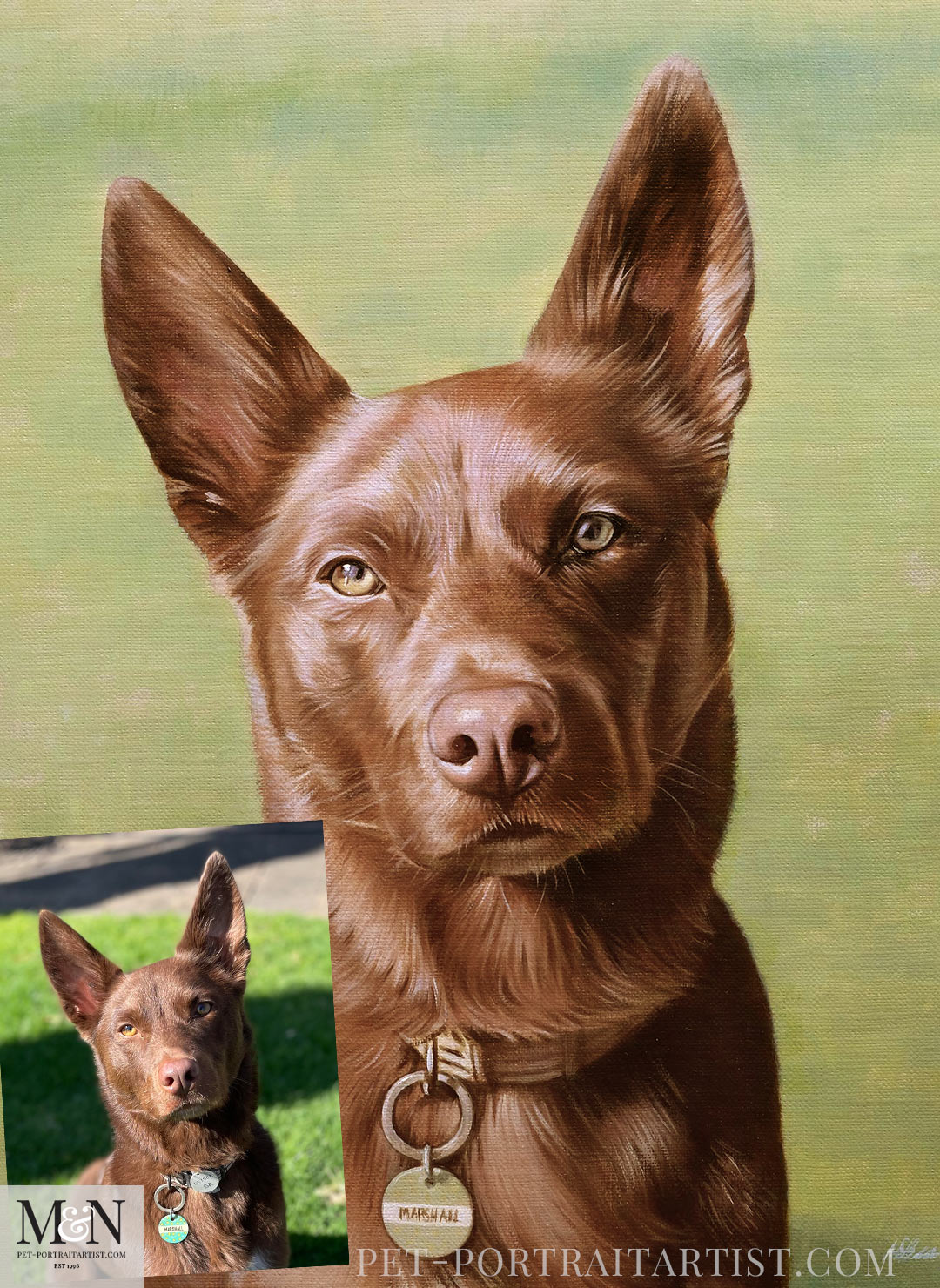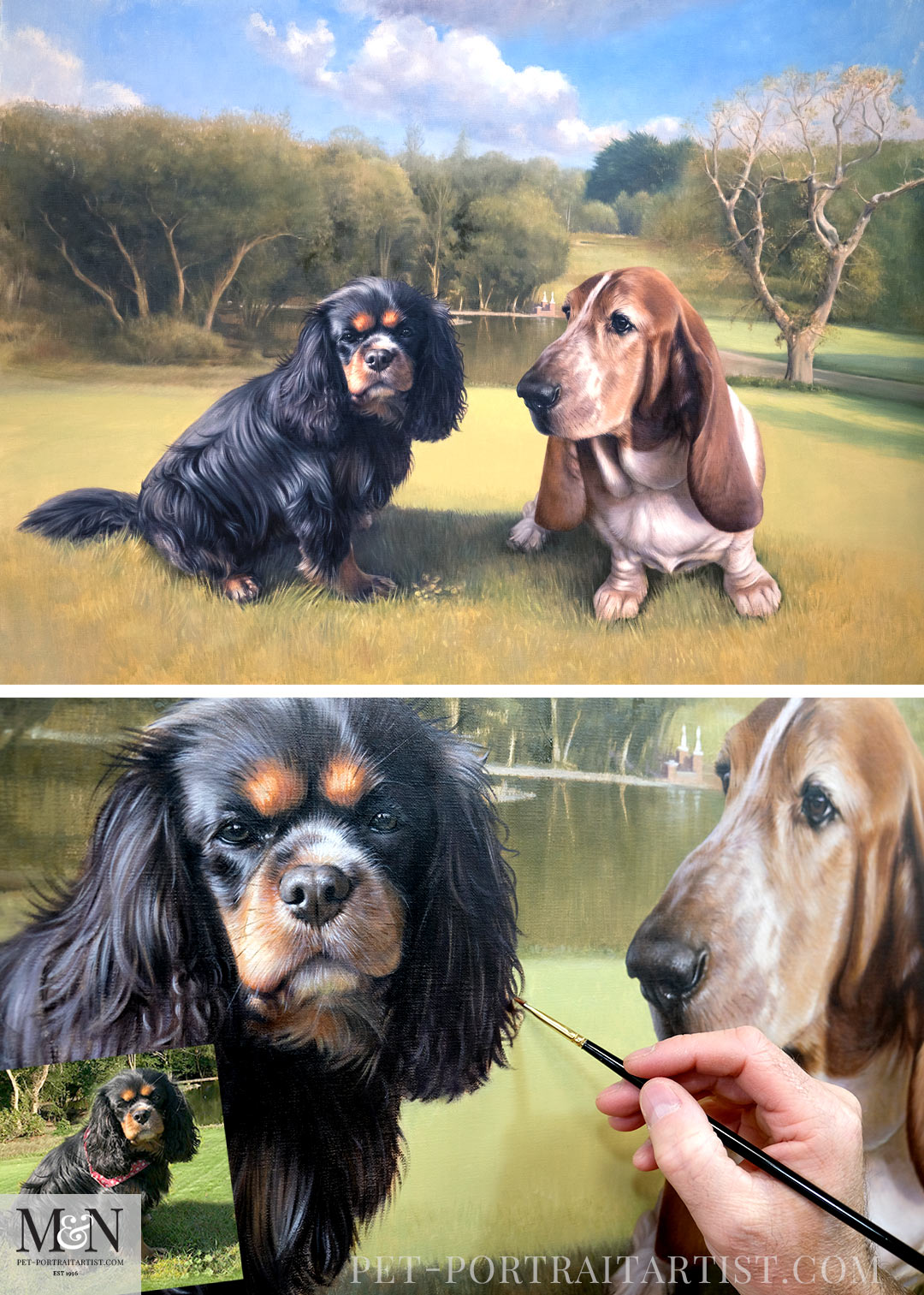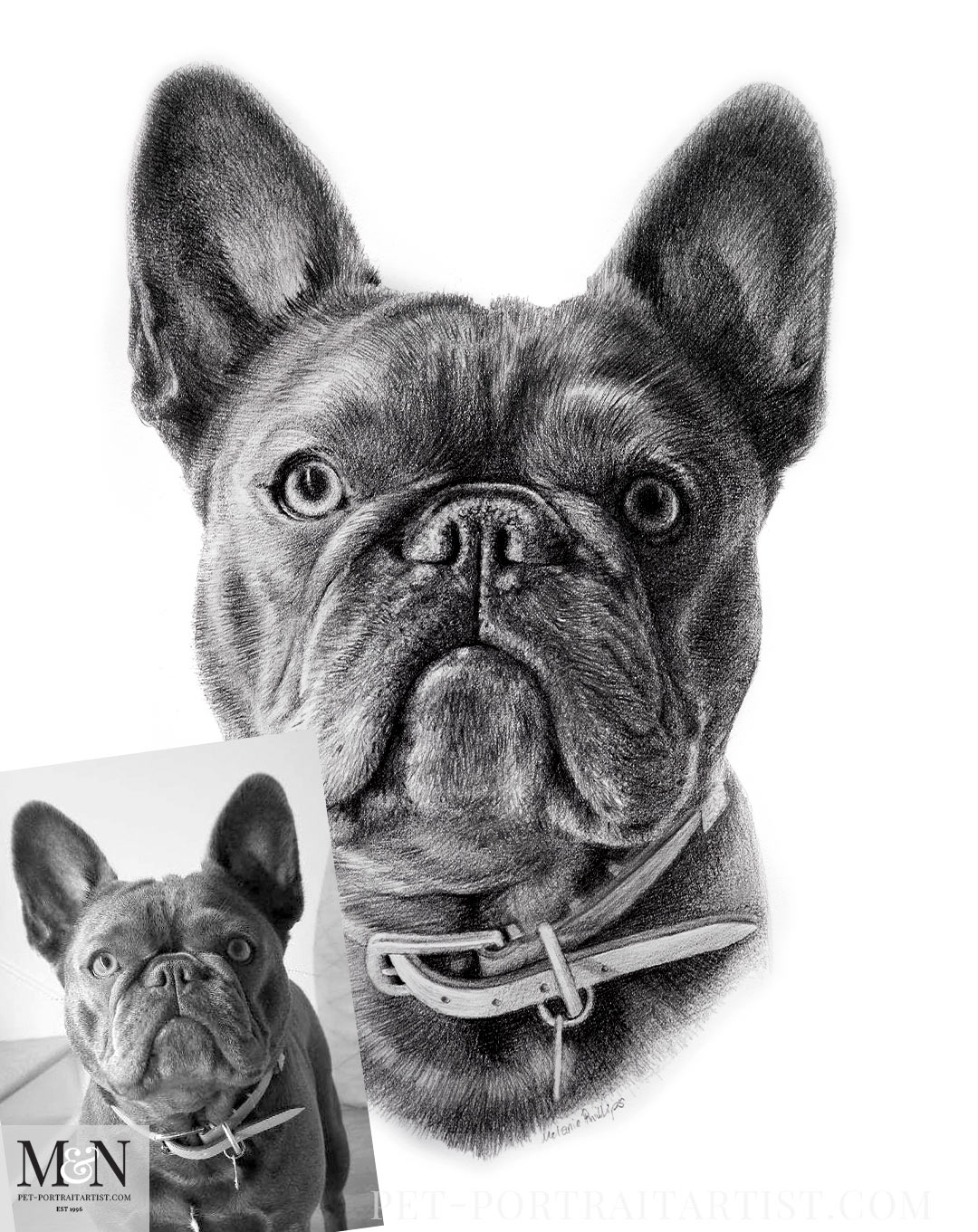I thought it would be a great subject to chat to our arty readers about the importance of light and shade pet portraits. As most artists do, we love visiting a gallery or two when we have time. Whether it be to look at old master paintings or to open our minds to modern art.
I think having an appreciation of all forms of art can definitely help you grow as an artist in whichever field you specialise. We also like looking at artwork online. Have you seen Whistlejacket up close on the National Gallery website? They have really close up detailed versions of paintings which are fascinating.
Something that nearly all of the amazing old paintings have in common are the inclusion of light and shade. For us in our artwork, particularly the oil paintings, this is absolutely key. If we have a commission of a pet who was sitting in the sunshine – the painting of the pet absolutely needs to be sitting in that sunshine.
Importance of Light and Shade
The pet portrait of Marshall below is a good case in point. Kimberly who commissioned the portrait said that he loves being outside, he lives in Australia and loves being on grass. So our brief was to capture Marshall in a realistic way, sitting out in the sunshine.
I would like to please commission an oil painting of Marshall in the 10×12 inch size if possible? Marshall loves to be outside in the green grass and he never grew into his ears!
As you can see in the final painting below, comparing it to the photo, it still retains the shadow on the right hand side. Perhaps a little less deep – as that’s the beauty of painting, you can alter the levels to enhance the piece. Overall as a stand alone dog, you can see the light and shade on Marshalls face which helps to make the dog realistic and three dimensional.

Light and Shade in Pet Portraits of a White Dog
Adding light and shade to a white dog is much more tricky. You don’t want to make the pet look ‘muddy’, but equally you need some deeper tonal ranges within the white fur. This will create the illusion of depth to the fur and three dimensional form.
The lovely portrait of Paddy, who was an elderly dog for a returning client, is one such example. In the photo you can really only just note the direction of light. Can you see it? There a source of light coming from the left throwing a shadow from Paddy’s front leg across the chair. This gives us a good indication of where the light is.
So in this portrait, Nicholas added cooler tones as an under layer first and then picked out the lighter white highlights with a white or variations of white paint. You can see that the right side of Paddy’s shoulder is not white at all, nowhere near. However, subconsciously we know its white. It is receding to the background and it’s solid. Because it’s painted in these tones and colours, it’s not taking away focus from the eyes and face, plus it doesn’t give Paddy a cut-out look. So here, even though the sunlight isn’t streaming into the room, light and shade in the painting is very important.

What If I Can’t See Any Light And Shade In The Photo?
When clients take photos of their pets indoors where the is no strong light, the photos can feel a little flat. This can be tricky to paint from and be able to create a successful three dimensional painting. One example of this is the portrait below of Denny. You can just about see some shadowing in the crease by his cheek and this was an important area to include. Anywhere that you can make the most of the shadowed areas in a portrait like this is key.
So for instance, the right of the muzzle on the right hand side, has to be darker to allow the lighter muzzle and whiskers stand out. Do you add light and shade in your pet portraits similar to this?

Utilizing Sunlight In An Outside Setting
If clients ask you to create a portrait where the pets are outside, it can be helpful to choose photos where the weather is bright and sunny. This helps to create a happy feeling to the painting. Light and shade play a huge roll in this kind of scene.
Quite often clients will provide a background photo that they like and then separate photos of the pets, which has happened in this painting below. The portrait of Bilbo and Mr Kipling was painted from three separate photos. Ideally photos of the pets taken in the same lighting situation is the most optimal. Otherwise it is tricky to change the lighting to a different direction on the dog itself to match the scene. It doesn’t always work.
For instance here in the painting below, we have a number of light sources and luckily they do all work. We have one light source coming from the right adding light to the right hand side of the large tree and a shadow on the left. Equally we have light on the right side of Bilbo the Basset. But we also have some light from above and on the left as we have light on the back of the King Charles Spaniel. Luckily this all works well but if there are too many inconsistencies with light sources and shadows, the the painting will fall apart.
The fundamentals of nature have to hold true, if the sun is shining on the left hand side of a dogs face, it simply cannot be shining on the right hand side at the same time. Learning how to observe light within the scene or photos that you are working from is key. It will pull your paintings together and make them feel more realistic when you do.

What If I Draw – Can I Still Add Light And Shade?
Yes! Everything you create whether it be a simple study in your sketchbook, or a detailed realistic painting. You still need to be looking for the light and shade in the scene. Just like the pencil drawing I have created of Memphis below. We can clearly see he has shadow on his right side and sunlight on his left. If I had omitted the shadow, the portrait would feel flat. It would still be an OK portrait. I have seen plenty of artists who draw without adding light and shade in their portraits. However they often lack realism.
One of my favourite exercises that I loved getting my students to do was to either draw a few apples in a row or a glass of water with a spoon in. Add a light source to the scene and sit and draw. You can set yourself time limits if you want. This doesn’t have to be a detailed drawing, just a sketch to capture the scene.
Make the observations of where the shadows are, where the light is, create the fundamental shapes and if you are drawing the apples, start shading the contours of the apple. If you are drawing the glass, note the refraction of water from the spoon in the glass too. Both exercises really make you sit and think. Each time we draw something like this it improves our observation skill. That’s what we need as pet portrait artists. Fundamentally we are looking at a photo and replicating on paper or canvas it in our own style. So we need to learn to look, note, and draw what we see. Observational drawing can help improve our skills. Don’t forget we are always learning. We must keep learning and should never stop.

Tips for learning how to look for light and shade
My top tips for artists who would like to learn more about the the importance of light and shade in pet portraits and who are interested in learning how to include light and shade into their work are as follows…
Look at the form and structure. Light reveals the three-dimensional form of an animal, while shadow adds volume and depth. By observing where shadows fall and where light hits, you can accurately depict the contours and structure of fur, breathing life into your subjects.
Look at fur texture and detail. Light accentuates the texture of fur, highlighting its softness, sheen or ruggedness. By carefully rendering the play of light on different fur types. Whether sleek and glossy or fine and fluffy, you can convey the tactile qualities of the subjects with realism.
Identify the light source in your photo – KEY. Before starting a pet portrait, determine the direction of the light in your reference photo. Whether it’s natural sunlight streaming through a window or artificial light casting shadows. Understanding the light source enables you to create the three dimensional form of the subject realistically.
Use tones and colour to create light and shade. Use a range of tones, from deep shadows to bright highlights, to create depth and dimension in your pet portraits. Gradually build up layers of colour and tone, blending to transition between light and shade to achieve a sense of solidity. Think about the white dog above and look at how Nicholas painted the shoulder. It’s still a white dog, but the paint doesn’t have to be pure white to be on the shaded side.
The Importance of Light and Shade in Pet Portraits
Thank you for reading my blog post the importance of light and shade in pet portraits. If you have got to the bottom of this article I really hope that you found it interesting and you have learnt something. If you missed my last post you might want to read about artists and time management. Its something I struggle with and I hope that it might help you too. Also don’t forget to follow and subscribe to our monthly news. If you have any subjects that you would like us to write about please do get in touch or leave a comment below.

Contact Us!
If you have a question or you would like to commission a portrait, contact us at any time. Don’t forget to subscribe to our YouTube Channel too.

Thank you for all this very useful information. I find everything you said also applies to portraits of people. Very reassuring, and as always wonderful examples.
Hi Gail, So lovely to hear from you! Nicholas only asked me the other day if I read any blogs and were they getting outdated technology. I said I hope not.. but I only read Gails!! 😀 I’m glad you found the blog useful. I see a number of artists omitting shadows and light and it’s bizarre they miss it out! It’s truly key in both pet and human portraits. Well all realism paintings really. I hope that you are keeping well and had a lovely Easter! xxx
🥰 thank you Melanie (and Julie!) – the feeling is mutual. Power to your pencil and brushes!
Absolutely!!
well that’s hilarious – hello Melanie AND Gail! I was just looking for ideas for a new lamp for my easel and reckoned Melanie would know, and found this lovely post! Thanks for the info, I will keep searching for a lamp but enjoyed reading these wise words and lovely that you know Gail! Hope all are well xx
Hi Julie! So lovely to hear form you and yes I do indeed know Gail! I love her work and blog posts. I hope that you are well and that you found a lamp!! Its been a really busy year here with life and work. I hope yours has been fabulous so far too! Melanie xx